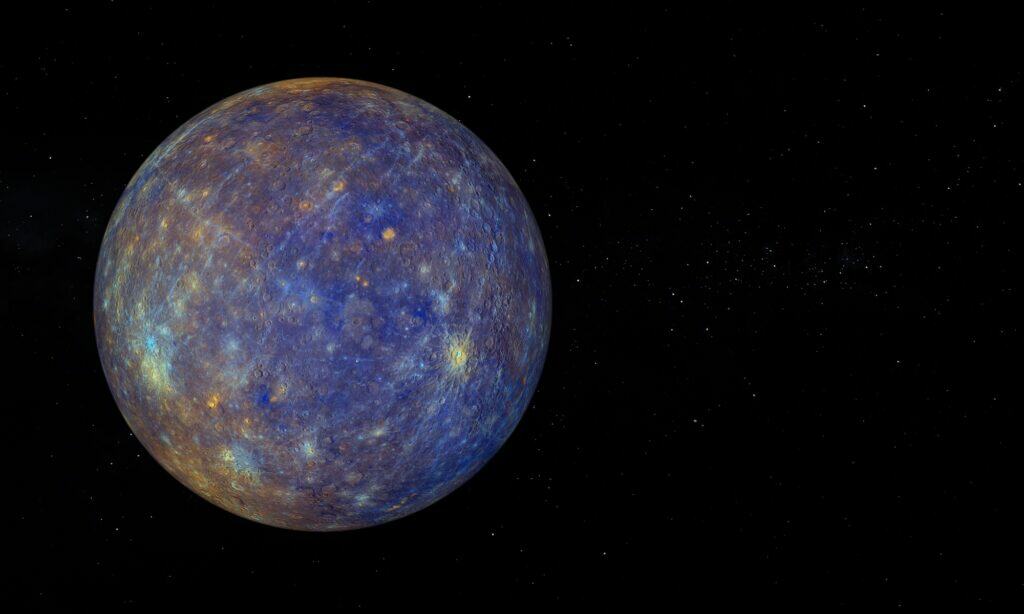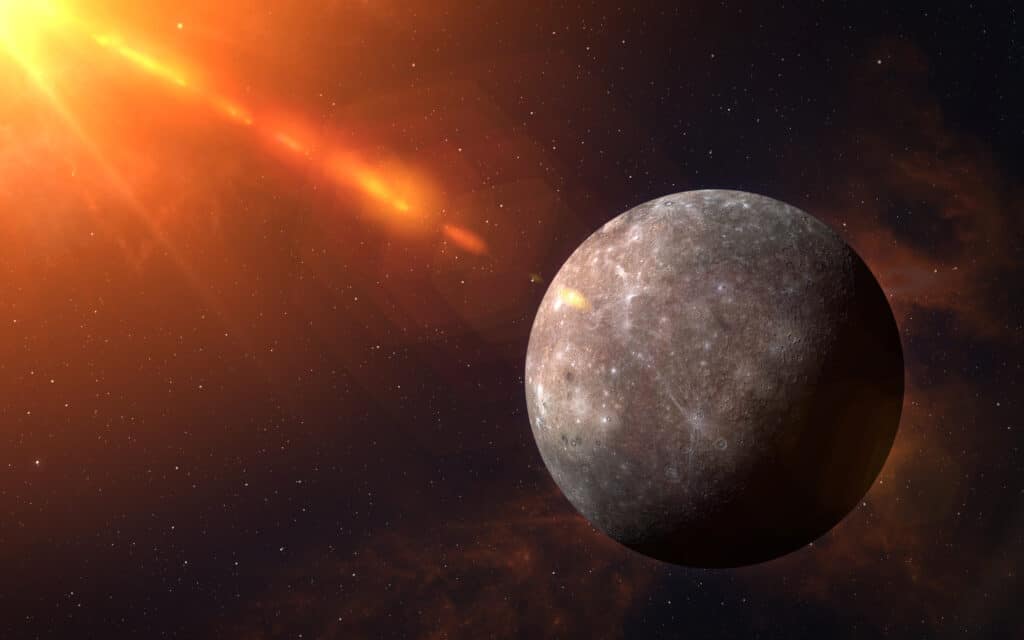Mercury is not only the smallest planet in the universe but also the closest to the Sun. One can expect quite extreme temperatures on its surface. You’ve probably guessed from the title of the article that they are not only extreme but exceptionally varied as well. No worries, you’ll find out more about this!
The planet has equatorial and polar regions, which is another aspect that influences the temperature.
The main characteristic of Mercury that contributes to temperature variety is the planet’s atmosphere. It has a very thin atmosphere, almost a vacuum, and as such, it cannot retain heat.
Beginner astronomers can easily recognize Mercury, as it shares similarities in appearance with the Moon – a plethora of craters and a grayish surface. Let’s now see how hot & cold the surface of the planet really is and what could survive there!
How hot & cold is the surface of Mercury really?

According to NASA, the mean temperature of Mercury is 333 °F.
©iStock.com/FlashMyPixel
The average temperature of Mercury’s surface is about 354 °F. This number, however, doesn’t showcase the actual temperatures on the planet. The sunny side of Mercury can get as hot as 800 °F, while the dark side is as cold as -330 °F. This is due to the planet’s thin atmosphere. It provides no protection for this celestial body and doesn’t retain heat.
As a result, Mercurial days are scorching hot, and the nights are about 130 °F away from absolute zero when molecular motion stops. In short, Mercury is a fascinating planet! For example, even if it’s the closest planet to the Sun, the day sky would still be pitch black, as there’s no actual atmosphere to propagate light. Imagine that – temperatures of about 800 °F in complete darkness!
Mercury also features lava flows, which, to some degree, probably contribute to the planet’s extreme temperatures. The planet’s poles, however, are never under direct sunlight, as the planet doesn’t tilt on its axis. This made scientists scan the areas, eventually finding signs of ice on the planet’s northern pole.
According to NASA, the mean temperature of Mercury is 333 °F (mean temperature accounts for temperatures across the entire surface of this rocky planet).
What could survive on Mercury?

No organism could survive Mecury’s both extremely low and incredibly high temperatures.
©HAKAN AKIRMAK VISUALS/Shutterstock.com
Mercury is a land of the extremes. No organism could survive this planet’s both extremely low and incredibly high temperatures. Even if we take into account extremophilic organisms, none could endure below-freezing and boiling temperatures.
Extremophilic organisms are divided into several types according to the temperatures they can survive at. Cryophiles can survive and grow at temperatures only as low as -13 °F, while hyperthermophiles can resist (not for long, though) temperatures as high as 266 °F.
Assuming that a hyperthermophile could survive Mercury’s scorching day heat, the organism would probably freeze to death once night settled in. The incredibly varied temperatures of this planet make it incompatible with life as we know it – any form of life present on Earth, for that matter.
What if temperatures there were decent? Even in that case, Mercury still wouldn’t be an ideal holiday destination for fungi or bacteria. The solar radiation levels are simply too high, not to mention the fact that, virtually, the planet doesn’t have an atmosphere.
Could tomato plants or other vegetables/fruits survive on the surface of Mercury?
Tomatoes, other vegetables, and fruits couldn’t survive Mercury’s extremely varied temperatures. Most plants can resist some frost during winter’s cold months, while the great majority can survive temperatures of up to 90 °F. However, none of these situations apply to Mercury.
Given that Mercury’s surface can experience temperatures as low as -330 °F and as high as 800 °F, it is clear that no living organism could survive there. The significant difference between day and night temperatures makes it virtually impossible for any living thing to adapt to this planet.
Could tardigrades survive on the surface of Mercury?
Tardigrades are the only animals that have survived after having been exposed to outer space. These microscopic organisms are also believed to be able to survive the apocalypse that will destroy all humanity. They are the most resilient organisms on Earth – but could they survive the surface of Mercury?
These animals can go into something called a tun state. Similar to hibernation, it is characterized by a dried and lifeless appearance, most likely for the purpose of preservation. In this state, tardigrades can survive temperatures as low as -328 °F and as high as 300 °F.
Given the temperatures on the surface of Mercury, tardigrades couldn’t survive there, as the temperatures are too extreme and too varied. At -328 °F, they can survive only for a couple of minutes, while anything above 300 °F will kill them.
Would water be frozen or liquid on the surface of Mercury?
Water would be rock-solid frozen on the surface of Mercury. As we all know, water freezes at 32 °F – it can’t get more frozen than that. At 32 °F, right before freezing, water is called supercooled. Once it starts freezing and temperatures drop even lower, it turns into a rock-solid material. At extremely low temperatures, ice can be as tough as rock.
However, it is worth considering that scientists are constantly working on developing ways to cool liquid water below its freezing point. According to research, they’ve been able to keep water liquid at temperatures of -49 °F.
During the day, water would evaporate quickly, as temperatures rise well above 212 °F, which is its boiling point.
Are there any signs of life on Mercury?

Mercury shows no signs of past or present life.
©iStock.com/buradaki
Mercury shows no signs of past or present life. The planet has no atmosphere and sits the closest to the Sun among the planets in our Solar System. It is very likely that Mercury will never experience life forms (known to humankind).
Ultimately, the planet’s temperatures are too varied to support any type of organism, be it psychrophiles or hyperthermophiles.
The main characteristics of Mercury
| Volume | Mass | Surface gravity | Average surface temperature | Predominant composition element | |
|---|---|---|---|---|---|
| Mercury | 0.056 Earths | 0.055 Earths | 0.38 g | 354 °F | Atomic oxygen |
| Earth | 2.59876×1011 cu mi | 1.31668×1025 lb | 1 g / 32.1740 ft/s2 | 57 °F | Nitrogen (78.08%) |
How long is a one-way trip to Mercury?
A one-way trip to Mercury is about 147 days long, less than a year. The first spacecraft to visit this planet was Mariner 10. It reached Mercury in 1974 after using Venus’ gravity to change its trajectory.
A longer route was used by the MESSENGER spacecraft – it reached the planet’s orbit almost four years from departure.
7 interesting facts about Mercury
Here are seven interesting facts about Mercury! If you’re interested in space exploration, then these might enrich your knowledge about one of the planets that we didn’t land on yet:
- Mercury is constantly shrinking. Research suggests that the planet lost about 9 miles in diameter in the past four billion years. This might be happening because the planet’s core is cooling, which causes Mercury to lose volume.
- Even though it’s the smallest planet in the Solar System, Mercury features a crater that could fit the whole of Western Europe. It is known as the Caloris Basin and has a diameter of 963 miles.
- Mercury spins quite fast around the Sun. One Mercurial year is about three Earth months. On the other hand, the planet spins slowly on its axis. A Mercurial day is as long as about two Earth months.
- Mercury is one of the two planets in our Solar System that doesn’t have any moons. The other planet is Venus. This is due to the planet’s low gravity, size, and distance from the sun.
- Mercury’s entire surface has been mapped by the MESSENGER probe over the course of four years.
- Mercury’s atmosphere is so thin that scientists use another scientific term to describe it – exosphere.
- Mercury’s magnetic field has a force of 1%, compared to the Earth’s. Even if it’s not powerful, it can cause magnetic tornadoes on the planet’s surface.
Up Next:
- This Is How Much You’d Weigh On Mercury
- This is How Cold The Surface of Saturn Really is, And What Could Survive There
- What’s the Largest Planet in Our Solar System?
The photo featured at the top of this post is © iStock.com/buradaki
Thank you for reading! Have some feedback for us? Contact the AZ Animals editorial team.






